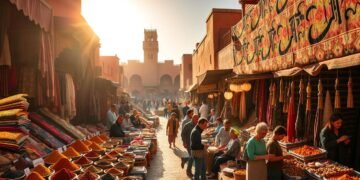Moroccan architecture is famous for its intricate details, vibrant colors, and unique style. One of the most iconic elements of Moroccan architecture is the Moroccan door. Moroccan doors are not just an entryway to a building; they are a work of art, a reflection of the owner’s personality, and an essential part of the Moroccan culture. In this article, we will explore the history, styles, and symbolism of Moroccan doors.
History of Moroccan Doors
Moroccan doors date back to the 7th century, where they were initially designed for functional purposes, such as security and privacy. As time passed, the Moroccan door evolved into a form of artistic expression. The intricate carvings, bold colors, and unique shapes of the Moroccan doors became an essential aspect of Moroccan architecture.
Styles of Moroccan Doors
Moroccan doors come in different styles, shapes, and sizes. Here are some of the most popular Moroccan door styles:
1. Zellige Doors
Zellige is a form of Moroccan mosaic art, where small pieces of ceramic, stone, or glass are used to create intricate geometric patterns. Zellige doors are known for their intricate designs and vibrant colors.
2. Carved Doors
Carved doors are a popular style of Moroccan doors, where intricate designs are carved into the wood using chisels and hammers. These doors are known for their intricate details and unique patterns.
3. Metal Doors
Metal doors are a modern style of Moroccan doors, where metal is used to create intricate designs and patterns. These doors are known for their durability and strength.
Symbolism of Moroccan Doors
Moroccan doors have a deep symbolic meaning in Moroccan culture. Here are some of the most common symbols found in Moroccan doors:
1. The Hand of Fatima
The Hand of Fatima is a symbol of protection and good luck in Moroccan culture. It is often found in Moroccan doors, where it is believed to ward off evil spirits and bring good luck to the occupants.
2. Geometric Patterns
Geometric patterns are a common feature of Moroccan doors. These patterns represent infinity and perfection and are often used to ward off evil spirits.
3. Islamic Calligraphy
Islamic calligraphy is a form of art that uses Arabic script to create beautiful designs and patterns. It is often used in Moroccan doors, where it is believed to bring blessings and good fortune to the occupants.
Where to Buy Moroccan Doors
If you are interested in purchasing a Moroccan door, there are several places where you can buy them. Here are some of the most popular places to buy Moroccan doors:
1. Souks
Souks are traditional Moroccan markets where you can find a wide variety of Moroccan doors. These markets are known for their vibrant colors, unique smells, and bustling crowds.
2. Online Retailers
There are several online retailers that specialize in Moroccan doors. These retailers offer a wide selection of doors, and you can browse and purchase from the comfort of your own home.
3. Moroccan Door Manufacturers
Moroccan door manufacturers are another excellent option for purchasing a Moroccan door. These manufacturers can create custom doors to your specifications and offer a wide range of styles and designs.
Maintaining Moroccan Doors
Moroccan doors require proper maintenance to keep them looking their best. Here are some tips for maintaining your Moroccan door:
1. Clean Regularly
Clean your Moroccan door regularly using a soft cloth and mild soap. Avoid using harsh chemicals or abrasive materials that can damage the door’s surface.
2. Seal the Door
Sealing your Moroccan door with a protective coating can help to protect it from the elements and prevent damage.
3. Handle with Care
Moroccan doors are delicate and require gentle handling. Avoid slamming the door, leaning against it, or putting heavy objects on it. Also, avoid using the door as a hanger for your belongings.
4. Repair as Needed
If you notice any damage to your Moroccan door, such as cracks or chips, it’s essential to repair it promptly. This will prevent further damage and ensure the door lasts for many years to come.
Incorporating Moroccan Doors in Your Home
Moroccan doors can add a touch of elegance and sophistication to any home. Here are some ways to incorporate Moroccan doors into your home:
1. As Entry Doors
Using a Moroccan door as your entry door is a great way to make a bold statement and create a welcoming entrance to your home.
2. As Interior Doors
Moroccan doors can be used as interior doors, such as bedroom doors, closet doors, or bathroom doors. This adds a touch of elegance to your home’s interior.
3. As Decorative Pieces
Moroccan doors can also be used as decorative pieces. Hang a Moroccan door on your wall to create a stunning focal point in your home.
Last but not least
Moroccan doors are a unique and essential aspect of Moroccan architecture. With their intricate designs, vibrant colors, and symbolic meanings, Moroccan doors are not just an entryway to a building but a work of art. By understanding the history, styles, and symbolism of Moroccan doors, you can appreciate the beauty and cultural significance of this architectural feature.
FAQs
No, Moroccan doors can be found all over the world, as they have become a popular decorative element in many homes.
Moroccan doors are typically made of wood, metal, or a combination of both.
Yes, many Moroccan door manufacturers offer custom-made doors to meet your specific design preferences.
You can use Moroccan doors as entry doors, interior doors, or decorative pieces in your home.
Yes, with proper maintenance and care, Moroccan doors can last for many years


























